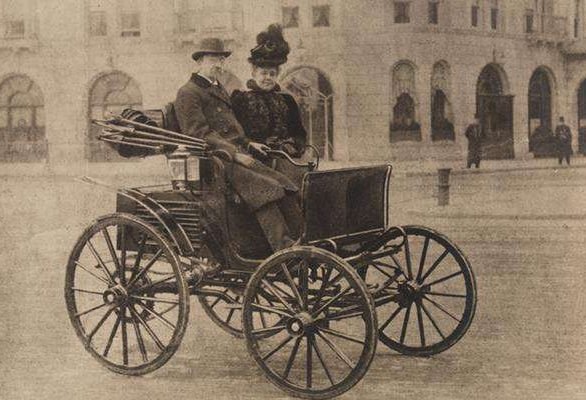
 There was no such thing as a Department of Motor Vehicles in the late 19th century, so there are no registration records to consult about who was the first owner of a car in New York City.
There was no such thing as a Department of Motor Vehicles in the late 19th century, so there are no registration records to consult about who was the first owner of a car in New York City.
One of the earliest cars seen on the streets of Manhattan was an “Allen” in 1885. It was manufactured at 304 West 53rd Street and featured wheels that were chain driven, like a motorcycle, and a tiller rather than a steering wheel.
One could speculate that someone named Allen was the manufacturer and first owner. But there is little substantiating information available.
In 1893 came a vehicle dubbed “the phantom phaeton,” regularly observed by astonished throngs on the crowded thoroughfares of
Central Park and Riverside Drive. A phaeton was a popular type of horse-drawn carriage with short sides and oversize wheels.
But this sporty carriage had no horses pulling it. It was propelled by a motor that was driven by gas, provided by ordinary benzine contained in a closed copper tank under the seat, and the car was steered by valves in front of the driver’s seat. A mystery to this day, its driver was never identified.
A Star of the Gilded Age
History needed a flamboyant man-about-town to inspire a lasting chronicle. And it got one in the person of “Diamond Jim” Brady, said to be New York’s very first recognized possessor of a motor car.
Brady was known for his lavish lifestyle and insatiable appetite. Having amassed a fortune in the finance and railroad industries,
he assembled a wardrobe of 200 custom-made suits, 50 glossy silk hats and a trove of jewelry worth in excess of $2 million.
This included a number of extravagantly large diamond rings, plus buttons, watches, belt buckles, tie pins, and cuff links studded with diamonds, and a walking cane whose head contained a three carat diamond.

 His custom-built electric “brougham” was a four-door closed-body vehicle with a separate driver’s compartment. Manufactured in 1895 by the Woods Motor Vehicle Company of Chicago (which built cars from 1899-1918), it was presumably just another bauble in Brady’s collection.
His custom-built electric “brougham” was a four-door closed-body vehicle with a separate driver’s compartment. Manufactured in 1895 by the Woods Motor Vehicle Company of Chicago (which built cars from 1899-1918), it was presumably just another bauble in Brady’s collection.
Upon delivery to Brady, the auto was accompanied by the firm’s mechanic, William Johnson. Never one to miss an opportunity for show, Diamond Jim dressed him in a bottle-green uniform and employed him with the official title of “chauffeur.” He first had Johnson drive him around the city in the wee hours of the morning, when no one was around, to make sure his new toy was reliable.
Then, after alerting the press, he directed his liveried chauffeur to showcase the vehicle by driving down Fifth Avenue to Madison Square.
Trouble in Auto Land
The new conveyance amazed and delighted the crowds gathered along the way. But horses on the road panicked. When the brougham reached the intersection at 42nd Street, no fewer than five teams of horses bolted in terror, precipitating
Manhattan’s first auto-related traffic jam.
Although the vehicle only attained speeds of 10 or eleven miles an hour, it caused so much disruption, the New York City Police
Department ordered Brady not to bring his machine out again during the day.
Regardless, by the next year, cars were a common sight in the city at any hour of the day. As of 1899 there was an official Automobile Club of America (1899-1932) headquartered at the Waldorf-Astoria Hotel, an annual automobile parade in downtown Manhattan, and the first recorded fatal car accident.
(Among the original directors of the club were IBM founder Charles R. Flint; balloonist Homer W. Hedge; and early oil industry investor V. Everit Macy.)

 A 69-year-old real estate dealer, Henry Hale Bliss, was fatally injured when he stepped off a south-bound 8th Avenue trolley on what was considered a “dangerous stretch” at Central Park West and West 74th Street.
A 69-year-old real estate dealer, Henry Hale Bliss, was fatally injured when he stepped off a south-bound 8th Avenue trolley on what was considered a “dangerous stretch” at Central Park West and West 74th Street.
While turning to help his female companion step down, he was struck by an electric-powered taxicab. Bliss hit the pavement, crushing his skull and chest.
(Although the cab driver, one Arthur Smith, was charged with manslaughter, the death was later ruled an accident and he was acquitted.)
As Diamond Jim Brady no doubt foresaw, he was, for a short while, in a class by himself. But as he gloried in automobile ownership, many others soon followed. For motor cars brought, and still bestow, the promise of unfettered mobility, travel to unfamiliar parts and personal freedom.
Brady died in 1917, blithely unaware of the New York City traffic maelstrom he had helped unleashed.
The article was first published in Blackwell’s Almanac, the newsletter of the Roosevelt Island Historical Society.
Read more about the history of motorsports in New York.
Illustrations, from above: Early automobile at the Hotel Empire Broadway and 62nd Street in Spring of 1898, on the back it says this car was designed in 1895-96 and built in 1896-7 (courtesy Museum of the City of New York); An 1890s electric brougham similar to that drive by Jim Brady; and a satirical postcard from 1908.








Recent Comments